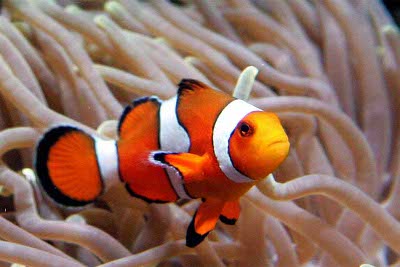ClownFish
Category: Aquarium Fish Other

Facts about Clownfish "Scientific name for Clownfish is Amphiprioninae". Anemone Demoiselle is the official name of the clownfish popularized in the movie “Finding Nemoâ€. The clown fish is also called the common clownfish, false clown anemone fish, Amphiprion melanurus, Amphiprion bicolor, false percula clownfish and ocellaris clown fish. The name false percula clownfish comes from the fact that the Anemone Demoiselle looks like the Percula clownfish, though the Percula species has thicker black lines and a less vibrant orange color. The clownfish lives throughout the Indo-Pacific Ocean.
Features of the Clownfish
The Clownfish is a bright orange to reddish orange except for two to three white stripes with black borders. clownfish grows to be 3 to 4.3 inches (7 to 11 cm) in length. Thats where thier name comes from the multicolored sea anemone that they are.
Origin of the Clownfish
The clownfish is best known for living in sea anemone. The anemone provides shelter, since its tentacles sting predators that would otherwise eat the clownfish.
Diet of the Clownfish
They are omnivores, relatively easy to take care of because they can eat almost any foods. They’ll eat fish pellets, fish flakes and live foods like mysis. They can be fed bristleworms, squid, nori, brine shrimp and spirulina. You can buy fish feed chips that don’t break up as quickly in the water. Larger meats and pellets may need to be broken down so that the clown fish can eat it.
Breeding of the Clownfish
The clownfish species can change gender. The larger fish is female, while the lesser fish are male. When the biggest fish dies, the next in the pecking order changes to female before laying the next batch of eggs. Any other clownfish in the group are probably sexually immature and won’t develop until there is room in the pecking order.
Aquarium living of the Clownfish
In your tank, the Clownfish will live in anemones or even long tentacled coral. If there is an anemone, the clownfish will live in it and rarely travel more than a few inches from it unless feeding. But you can have clown fish without an anemone, but they will need rocks with caves to hide in. Clownfish will not eat corals, invertebrates or live rocks. They are territorial toward other clownfish and damsel fish. They should not share a tank with anglers or frogs nor any large predatory fish like sharks.
Aquarium care of the Clownfish
Test the water when preparing your tank for your Clownfish: You will need to purchase a liquid tester so that you can test for Nitrates and Ammonia. The strip-style test kits are unreliable and a waste of money. You should use a dechlorinating product to remove the harmful chlorine from the water. Test for nitrite, ammonia, and proper pH 8.2 to 8.4. They need temperatures around 73 to 80°F (22 to 27 cel). The water hardness should be 8 to 12 dKH. They do best when the water hardness is 1.020 to 1.025, a slightly broader range than other salt water fish. The ammonia should always be 0, the nitrite should be 0, and the nitrate should preferably be below 20 ppm. If it's at or above 40 parts per million (ppm), you have too many fish or are not changing the water often enough. Cycling your tank is important, Follow the steps to cycle your tank. This establishes healthy bacterial and chemical levels.
Remove 30% of the water from your Clownfish tank each month with new water, or a 15% water change every 2 weeks is ideal for keeping nitrates lower. With corals in the fish tank, then 20% water change every month, or 10% change every 2 weeks.

 Back To Category Aquarium Fish Other
Back To Category Aquarium Fish Other